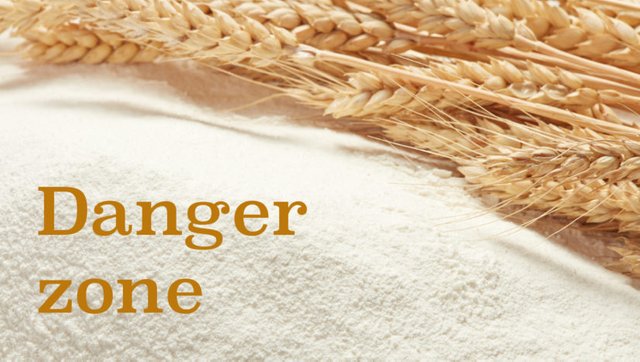»»»uncooked flour - it's said to be a possible contamination source... never sprinkled raw flour on bread or any food!

uncooked unbaked
*** flours must always be cooked ***
there could be many contaminant's
like a mice or an insect or mould aflatoxin in a storage house during transport...
a
it should be actually fermented and cooked and never sprinkled raw on bread or any food!
references :
www.fda.gov › food › buy-store-serve-safe-foodHandling Flour Safely:
What You Need to Know | FDA
Processing raw grains into flour does not kill harmful bacteria. Many foods made with flour also contain raw eggs, which may contain harmful bacteria. Cooking is the only way to be sure....
www.world-grain.com › articles › 10205-flour-millFlour mill contamination | World-grain.com | May 15, 2013 14: ...
15/05/2013 · Heat treatment of the flour after milling is a proven strategy to reduce bacterial and microbial contamination. Heating can have significant impact on flour functionality and, in fact, is used as a treatment to change flour functionality. Water absorption, gluten strength and dough stability are all quality characteristics that can be impacted using heat treatments. For these reasons, the use of heat to reduce microbial contamination poses significant risks and potential at the same time.
www.cdc.gov › ecoli › 2019Outbreak of E. coli Infections Linked to Flour | E. coli ...
11/07/2019 · Any flour or raw eggs used to make dough or batter might be contaminated with harmful germs. Bake or cook food made with raw dough or batter before eating it. Follow the recipe or instructions on the package. Do not use recalled flour in cooking or baking. Do not taste raw dough or batter. Even tasting a small amount could make you sick.
pubmed.ncbi.nlm.nih.gov › 10078168Flour contamination as a source of lead intoxication - PubMed
Results: Following detailed examination of the potential sources common to all members of the household, the cause of poisoning was determined to be corn flour containing 38.7 mg/g lead. Physicians are reminded to consider lead poisoning in the differential diagnosis of individuals with unexplained symptoms, particularly those of abdominal discomfort and anemia.
fsi.colostate.edu › flour-draftFlour | Food Source Information - Colorado State University
Foodborne outbreaks involving flour have implicated Salmonella, Shiga-toxin producing Escherichia coli(STEC), and preformed toxins or other short-acting agents. Flour has not been a food of major concern until recently as illnesses have been associated with the consumption of raw flour or products containing raw flour, such as raw cookie dough or b...
Voir la liste complète sur fsi.colostate.edu
www.marlerblog.com › legal-cases › contaminatedContaminated Flour – Something else to worry about?
14/01/2010 · 1. What did Nestle (and the entire flour industry) know about the risk that uncooked flour can be contaminated with a pathogen? Interesting, that discussion has been going on over at the FoodSafe Listserve both yesterday and today. Some cited examples of prior studies can be found below. 2. What testing protocols did Nestle use on cookie dough ingredients after June 2009 and what were the test results? Being an industry leader requires transparency.
www.foodsforbetterhealth.com › wheat-flourWheat Flour Contaminated By Peanuts and No One Seems to Know ...
The FDA is urging anyone with peanut allergies to avoid these products until the full scope of the contamination can be traced and understood. Since the FDA is currently heading the investigation into the peanut problem, any further recalls will be issued by the agency if other products are deemed to have been affected. Grain Craft is among the largest independent flour millers in the United States, so the possibility of other food products being involved is very real.
www.ukflourmillers.org › flourmicrobiologyFlour microbiology - UK Flour Millers
10/08/2022 · In order to do this, UK Flour Millers members fund a monitoring programme that closely examines the microbiological content of flours. Since 1971, an annual survey of the microbiological condition of white flours has been carried out using samples from UK Flour Millers

img and src: foodsafetynews